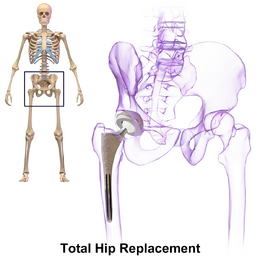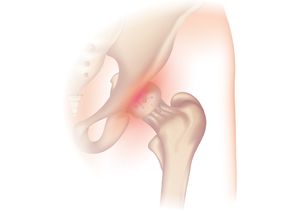Hip Disability and Osteoarthritis Outcome Score
Original Editor - Sanne Delporte
Top Contributors - Sanne Delporte, Lucinda hampton, Chloe Waller, Admin, Kim Jackson, Evan Thomas, Scott Buxton, WikiSysop, Uchechukwu Chukwuemeka, Lauren Lopez and Bridgit A Finley
Objective[edit | edit source]
The hip disability and osteoarthritis outcome score (HOOS) is a questionnaire intended to be used to assess patient’s opinion about their hip and associated problems, and to evaluate their symptoms and functional limitations during a therapeutic process [1][2].
The HOOS is an extension of the Western Ontario and McMaster Universities Osteoarthritis Index (WOMAC) and Knee Injury and Osteoarthritis Outcome Score (KOOS) [1].
Intended Population[edit | edit source]
This measuring instrument is recommended when there are symptoms of hip disability, with or without osteoarthritis (OA).
Hip osteoarthritis is a common, chronic musculoskeletal condition and a cause of pain, functional disability and reduced quality of life [3].
The HOOS is meant to be used over short and long-term intervals to assess changes over time or effect of treatment (medication, physiotherapy, operations) [2].
Factors that should be considered when using the HOOS include age, sex, weight, geographic location, other chronic diseases, history of an inactive hip problem, contralateral hip disease, and active knee, ankle, or foot problems[4][5][6].
Implementation[edit | edit source]
The HOOS questionnaire is a patient-administered self-report questionnaire and takes 7 to 10 minutes to complete. It is designed to be self-explanatory and user-friendly[1]. The HOOS includes 40 items with five possible responses, graded from 0 to 4 (0 points = worst possible score; 100 points = best possible score). To answer the questions, standardized answer options are given in 5 Likert-boxes with scores from 0 to 4 (no, mild, moderate, severe and extreme). The HOOS has five subcategories:
- Pain (10 items with a total score of 40 points)
- Symptoms and stiffness (five items with a total score of 20)
- Activities of daily living (17 items with a total score of 68)
- Function in sports and recreational activities (four items with a total score of 16)
- Quality of life (four items with a total score of 16)
HOOS 12[edit | edit source]
Other versions of the HOOS have been developed based on the original 40-question questionnaire, for example, the HOOS PS (five items), HOOS JR (six items) and the HOOS-12.[7] The HOOS-12 is a 12-item measure derived from the original HOOS. HOOS-12 contains
- 4 HOOS Pain items,
- 4 HOOS Function (Activities of Daily Living and Sport/Recreation) items
- 4 HOOS Quality of Life (QOL) items.
HOOS-12 is easier to complete than the original HOOS . As with the full-length HOOS survey, HOOS12 is intended to elicit people’s opinions about the difficulties they experience due to problems with their hip and covers aspects of pain, functional limitations and hip-related quality of life.[8]
The HOOS-12 has been found to be a reliable and valid alternative to HOOS in THR patients with moderate to severe OA and provided three domain-specific and summary hip impact scores with substantially reduced respondent burden.[9]
HOOS-12 scale scores are modified so 0 is the worst possible and 100 is the best possible score, similar to the method used to score the original HOOS scales. A HOOS-12 calculator is available at https://orthopowertools.com/HOOS12.
100
Results[edit | edit source]
Once the patient has completed the questionnaire, each subscale is calculated a standardized score, using following formula:
- 100 – [(patient's score of the subscale x 100)/(total score of the subscale)]
Each subscale will get a score of 0 to 100, with 0 indicating extreme symptoms and 100 indicating no symptoms. The subscales can be plotted as a HOOS profile, by connecting the mean scores for all 5 dimensions with a line[1][2].
Evidence[edit | edit source]
- Reliability: The Dutch version has good internal consistency and reliability [10]. The Brazilian Portuguese version also showed high internal consistency via test-retest reliability[11]. A meta analysis by Braaksma et al (2020) reviewing a modified short form version, the Hip Disability and Osteoarthritis Outcome Score - Physical Function Shortform (HOOS-PS), found moderate evidence supporting sufficient reliability and internal consistency[12]. The HOOS score is entirely based on patients' self-report of functional status and performance. This may be a disadvantage in comparison to instruments that include objective physical examination, so it is recommended to use the HOOS score as a tool to complete additional information and assessment [13].
- Validity: The construct validity is good with absence of floor and ceiling effects [10]. The Brazilian Portuguese version showed good construct validity with the Graded Chronic Pain Scale[11]. Moreover, it is highly correlated with the Oxford Hip Score[14]. The HOOS is valid in a sample of subjects at a mean of 3 years after hip arthroscopy and for patients with different stages of hip OA [10][13]. However, Braaksma et al (2020) also found the HOOS-PS had inconsistent content validity, insufficient construct validity and indeterminate responsiveness[12].
- Responsiveness: Thanks to the addition of two subscales, sport and recreation function (SP) and hip related quality of life (QOL), the HOOC shows a higher sensitivity and responsiveness, compared to the Western Ontario and McMaster Universities osteoarthritis index (WOMAC). Higher responsiveness was found in all five subscales with patients younger than 66 years old compared with those older than 66 years old [1]. In a study of the Polish version, responsiveness was deemed high, as the expected pattern of effect sizes was found in all subscales[15].
- Considerations: It is recommended to use the HOOS in conjunction with other outcomes measures[16]. It is useful compared with the Nonarthritic Hip Score and the modified Harris hip score (MHHS) [13], and when used alongside the Patient-Specific Complaints Instrument, the Numeric Pain Rating Scale and the Six Minute Walk Test[17].
Links[edit | edit source]
References[edit | edit source]
- ↑ 1.0 1.1 1.2 1.3 1.4 Nilsdotter AK, Lohmander LS, Klässbo M, Roos EM. Hip disability and osteoarthritis outcome score (HOOS)--validity and responsiveness in total hip replacement. BMC Musculoskelet Disord. 2003 May 30;4:10
- ↑ 2.0 2.1 2.2 Koos.nu. What is the HOOS? Available from: http://www.koos.nu/ (Last accessed 08/09/2022)
- ↑ Poulsen E, Christensen HW, Roos EM, Vach W, Overgaard S, Hartvigsen J. Non-surgical treatment of hip osteoarthritis. Hip school, with or without the addition of manual therapy, in comparison to a minimal control intervention: protocol for a three-armed randomized clinical trial. BMC Musculoskelet Disord. 2011 May 4;12:88
- ↑ Yu RW, McLean JM, Bahl JS, Solomon LB. Hip Disability and Osteoarthritis Outcome Score and Western Ontario and McMaster Universities Osteoarthritis Index Values in Asymptomatic and Arthritic Cohorts. Orthopedics. 2019 Mar 1;42(2):e216-e224.
- ↑ Raja A, Jenkins A, Reams M, Horst PK. Normative Data of the Hip Disability and Osteoarthritis Outcome Score, JR in a Healthy United States Population. J Arthroplasty. 2019 Jun;34(6):1122-1126.
- ↑ Katakam A, Florissi IS, Colon Iban YE, Bragdon CR, Chen AF, Melnic CM, Bedair HS. Class III Obesity Increases Risk of Failure to Achieve the 1-Year Hip Disability and Osteoarthritis Outcome Score-Physical Function Short Form Minimal Clinically Important Difference Following Total Hip Arthroplasty. J Arthroplasty. 2021 Jan;36(1):187-192
- ↑ Putman S, Preda C, Girard J, Duhamel A, Migaud H. Mapping and crosswalk of the Oxford Hip Score and different versions of the Hip Disability and Osteoarthritis Outcome Score. Clinical Orthopaedics and Related Research®. 2021 Jul 1;479(7):1534-44. Available:https://www.ncbi.nlm.nih.gov/pmc/articles/PMC8208448/ (accessed 7.12.2022)
- ↑ KOOS What is HOOS 12? Available:http://www.koos.nu/hoos12userguide.pdf (accessed 7.12.2022)
- ↑ Gandek B, Roos EM, Franklin PD, Ware Jr JE. A 12-item short form of the Hip disability and Osteoarthritis Outcome Score (HOOS-12): tests of reliability, validity and responsiveness. Osteoarthritis and Cartilage. 2019 May 1;27(5):754-61.Available: https://www.oarsijournal.com/article/S1063-4584(18)31515-2/fulltext (accessed 7.12.2022)
- ↑ 10.0 10.1 10.2 de Groot IB, Reijman M, Terwee CB, Bierma-Zeinstra SM, Favejee M, Roos EM, Verhaar JA. Validation of the Dutch version of the Hip disability and Osteoarthritis Outcome Score. Osteoarthritis Cartilage. 2007 Jan;15(1):104-9.
- ↑ 11.0 11.1 Machado RK, Casagrande AA, Pereira GR, Vissoci JRN, Pietrobon R, Ferreira APB. Hip Disability and Osteoarthritis Outcome Score (HOOS): A Cross-Cultural Validation of the Brazilian Portuguese Version Study. Rev Bras Ortop (Sao Paulo). 2019 May;54(3):282-287
- ↑ 12.0 12.1 Braaksma C, Wolterbeek N, Veen MR, Prinsen CAC, Ostelo RWJG. Systematic review and meta-analysis of measurement properties of the Hip disability and Osteoarthritis Outcome Score - Physical Function Shortform (HOOS-PS) and the Knee Injury and Osteoarthritis Outcome Score - Physical Function Shortform (KOOS-PS). Osteoarthritis Cartilage. 2020 Dec;28(12):1525-1538
- ↑ 13.0 13.1 13.2 Martin RL, Philippon MJ. Evidence of validity for the hip outcome score in hip arthroscopy. Arthroscopy. 2007 Aug;23(8):822-6.
- ↑ Putman S, Preda C, Girard J, Duhamel A, Migaud H. Mapping and Crosswalk of the Oxford Hip Score and Different Versions of the Hip Disability and Osteoarthritis Outcome Score. Clin Orthop Relat Res. 2021 Jul 1;479(7):1534-1544.
- ↑ Gojło MK, Paradowski PT. Polish adaptation and validation of the hip disability and osteoarthritis outcome score (HOOS) in osteoarthritis patients undergoing total hip replacement. Health Qual Life Outcomes. 2020 May 12;18(1):135
- ↑ KNGF Guideline. Osteoarthritis of the hip-knee. 2018. Available from: https://www.kngf2.nl/binaries/content/assets/kennisplatform/onbeveiligd/guidelines/artrose-heup-knie-2018-prl-en-toelichting-eng_def.pdf (Last accessed 08/09/2022)
- ↑ van Doormaal MCM, Meerhoff GA, Vliet Vlieland TPM, Peter WF. A clinical practice guideline for physical therapy in patients with hip or knee osteoarthritis. Musculoskeletal Care. 2020 Dec;18(4):575-595








